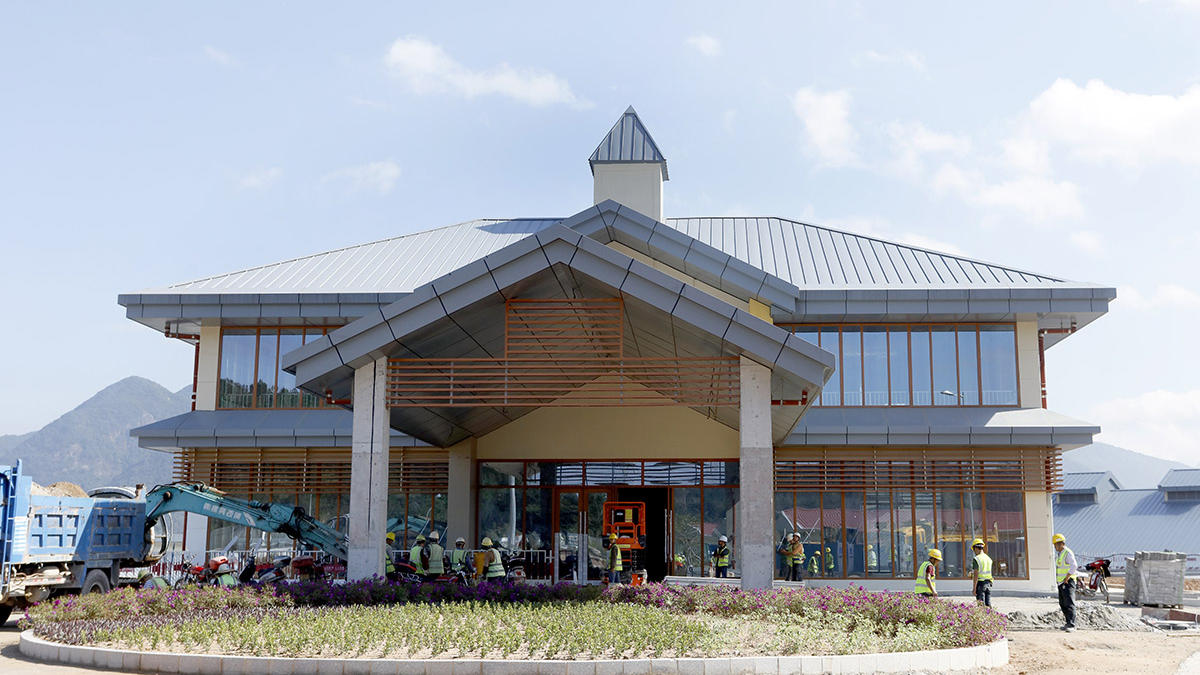
The Hong Kong Jockey Club’s magnificent new Conghua Training Centre is due to open in mainland China in August. And it looks set to be a gamechanger, elevating the jurisdiction still further in world racing. Kristen Manning reports.
For two decades, the Hong Kong Jockey Club has been keen to expand. It has had the financial means, the motive of a flourishing local racing industry and the support of all those involved. What it did not have was space.
When the Club was formed by a group of enthusiastic racing fans in November 1844, finding a suitable location for a racetrack was not so much of an issue, and Happy Valley was built a year later on what used to be swampland, the first meeting taking place in 1846.
And racing in Hong Kong has not looked back, Sha Tin established on reclaimed land in 1978. It is now home to the Longines Hong Kong International Race Day each December, a day that racegoers Down Under keep a close eye on, with the likes of Sunline, Falvelon, Monopolize, Catalan Opening, Our Grey Invader, Kessem and Romanee Conti proving great representatives for Australasia.
The competition has gotten tougher in recent years, with Australian and New Zealand runners finding it harder to get into the winner's circle, although several of the big day’s major stars have carried (AUS) and (NZ) suffixes; such as Silent Witness, Sacred Kingdom, Fairy King Prawn and Vengeance Of Rain.
Initial aim realised
December 2017 was dominated by locally trained horses, but the International Sprint winner Mr Stunning, a son of Exceed And Excel, was bred in Australia while Beauty Generation proved too strong for his rivals in the International Mile. The New Zealand-bred son of Road To Rock raced in Australia as Montaigne, winning at Randwick and finishing second to Tarzino in the G1 Rosehill Guineas.
The success of the day is something that the Hong Kong Jockey Club’s Winfried Engelbrecht-Bresges is extremely proud of, especially as it has realised its initial aim: to enhance the overall quality of Hong Kong racing and horses.
It was 1998 that saw the first Hong Kong-trained horse, Johan Cruyff, make it into the international rankings (now the Longines World’s Best Racehorse Rankings), a figure that increased to eight in 2008, to 21 by 2013 and 26 in 2016. Some eight percent of the world’s highest-rated horses call Hong Kong home and all 11 of Sha Tin’s major races feature in the world’s top 100 G1 races, according to the Longines/IFHA (International Federation of Horseracing Authorities) figures.
But still there are limitations, with the 22 trainers currently working in Hong Kong permitted a maximum of 60 horses each and the current equine population capped at 1,230. The racing is competitive and exciting but there is a lengthy waiting list of owners, who wait four years for a permit, and the Club is keen to increase the numbers.
Alluring possibility
For two decades it wondered how. “We tried for years to source land but it was impossible,” Engelbrecht-Bresges said. And then along came the 2010 Asian Games at Guangzhou, two years after Sha Tin was used to house the horses competing in the 2008 Beijing Olympics.
From which an alluring possibility arose. There is plenty of space in China.
And so an agreement was reached to purchase and develop “a major piece of land” in Conghua, 139 km north of Hong Kong.
Known for its hot springs, Conghua is already a popular destination for local tourists, and its mayor, recognising that the presence of the Hong Kong Jockey Club is only going to increase awareness, has been supportive.
Not that all has been smooth sailing, Engelbrecht-Bresges describing the development of the Conghua Training Centre as “probably the most demanding and significant project the Club has ever undertaken”.
“We have overcome many challenges,” he said, “from establishing the first equine disease-free zone in China ... to obtaining special permission for cross-border transportation of horses, for our veterinarians to practise in China, to be able to import feed and medication and to establish the first comprehensive equine clinic on the mainland.”
All the time keeping in mind that gambling is prohibited, the Club worked hard to establish good working links with officials while its overriding aim for a new training centre was to build something perfect for trainers, owners, riders and workers and, most of all, for the horses.
“The horse comes first,” said John Ridley, Director Of Capital Racing Projects. “A happy horse gives his best.”
CHECK OUT THIS TIME-LAPSE VIDEO OF THE TURF INSTALLATION
And so the Hong Kong Jockey Club has worked to ensure that Conghua is a showpiece Thoroughbred establishment, one that consists of a 2000m turf track (a 400m home straight with a one percent rise and a 674m home bend with transitional curves) with the same grass profile as Sha Tin, as well as large and small all-weather tracks, two trotting rings and an 1100m turf uphill gallop sloped at a continuous 1.5 percent.
Eight single story and one double story stable blocks for horses in training are designed to accommodate two trainers per divided stable, each with 34 stables and eight turn-out yards per wing, as well as two larger-than-usual isolated stallion stalls, inside and outside wash stalls and two covered walking machines.
In total, there are 664 individual CCTV monitored stalls, serviced by an equine clinic, chilled salt-water spas, aqua treadmills, a water walker, a covered and heated 70m long swimming pool and 20 turf paddocks with shelter, feed bins and automatic water.
Ideal environment for stallion prospects
Horses will never come into contact with vehicles, with each having its own access ways, while deliveries will be made away from the stables so as not to cause any disruption.
The provision of paddocks in a quiet area beyond the stables and tracks is a significant step for the Hong Kong Jockey Club with Engelbrecht-Bresges recognising that Sha Tin is, particularly for young horses, “an intense environment”.
It will enable horses to be imported at a younger age as they can now be given time to develop and mature and to acclimatize and, along with the stallion boxes, it will also be easier to keep promising males entire.
“Our prize money levels are attractive, but we need to keep adding value to the ownership experience,” Engelbrecht-Bresges said, noting that Hong Kong is the ideal environment to produce stallion prospects.
“Our racing is of a high quality, it is substance-free and breeders know that a stallion who has raced in Hong Kong is genetically sound and not influenced by medication.”
It was a timely discussion given that Archipenko (who sadly died recently), winner at Sha Tin of the G1 Queen Elizabeth II Cup in 2008 was represented by a big winner at this year’s International meeting, Time Warp impressively claiming the G1 Hong Kong International Cup.
Meanwhile, winning in Hong Kong in recent years has done plenty to enhance the reputation of such stud prospects of Maurice, Lord Kanaloa and Highland Reel.
Chosen as one of the first trainers to complement his Sha Tin stables with a base at Conghua is Caspar Fownes, who said that he “feels very privileged” to be part of the new establishment.
“It is an outstanding state-of-the-art training complex, with access to several beneficial facilities that we don’t normally have access to in Hong Kong, such as spelling paddocks, uphill gallops and water walkers. I am sure that I will be able to use the set up to my advantage.”
Conghua is designed, said John Ridley, with “further expansion in mind. We can continue to grow over time”.

Not only is there room for more stables and tracks, but space has been allotted for the equine clinic to expand with future plans for MRI, CT and scintigraphy equipment. Such a high standard is the veterinary care that Dr Christopher Riggs, Head Of Veterinary Clinical Services, joked: “If I were a horse, I know where I’d want to live!”
A major challenge in the establishment of Conghua has been assuring that racehorses never come into contact with disease. The welfare of horses is paramount, firstly for their own wellbeing and secondly for the economy of both horse racing and Hong Kong.
“We will not compromise on horse health,” Engelbrecht-Bresges said, noting that the Hong Kong Jockey Club pays HK$12 billion in taxes each year, around four to five percent of Hong Kong’s revenue. “And so the government do not want us to take any risks either.”
Security at Conghua is exceptionally tight (comings and goings monitored not only by the Club but by government officials) and the training centre is in the midst of a 2000 square km horse-free zone. And there are no horses 1km each side of the freeway en route. “Even if horses have to be unloaded for any reason, there will be no contact with local horses,” said Dr Brian Stewart, Head Of Veterinary Regulation And Biosecurity Policy.
Electrified fencing and buried concrete
Mindful that diseases such as rabies are present in China, Dr Stewart added that the 2.3 metre high electrified fencing (supported by 600mm of buried concrete to prevent burrowing) surrounding Conghua is specially designed to make it impossible for a wild animal to penetrate the borders.
“There is just so much at stake,” he said. while admitting that “the greatest risk is people”. Which is why strict protocols, overseen by quarantine officials from around the world, are in place while everyone involved is highly trained and experienced.
“Hong Kong has safely imported and exported thousands of horses over the past 25 years,” Dr Stewart noted, “and we have successfully managed international racing events, temporarily importing up to 40 Thoroughbreds from many countries each year. Our disease surveillance and preventative health measures are second to none.”
At present, every horse in Hong Kong has its temperature taken twice daily, with every horse displaying fever symptoms immediately tested. “This is the most effective and sensitive early detection system.”

Around 450 people (including strappers, track riders and farriers) have been seconded from Hong Kong to work at Conghua while locals (over 1,500 applied when 100 stable-assistant positions were advertised and there were similar numbers for riders) will be trained at the Huangcun Sports Institute. Twenty five track riders, who also spend time at Sha Tin, have been in training since 2016.
Another challenge for the Hong Kong Jockey Club has been convincing local owners that sending their horses across the border is a good idea. The typical Hong Kong owner is very involved with his or her horse, and the typical resident rarely has the need to spend much time travelling. Nor are they used to their horses spending much time in floats.
And so the Club is producing a regular newsletter to keep owners up to date, one assurance coming in the form of international comparison. “To take a common English route, the journey is roughly the distance from York to Newmarket,” said KL Cheng, Head Of Dual Site Stable Operations And Owners’ Services.
Dedicated travel grooms have been trained and each convoy of trucks will be accompanied by a security car, a veterinarian and a mechanic. The journey is monitored with live GPS tracking with CCTV vision (and recording) of each horse and regular reporting to control centres at Sha Tin and Conghua.
Minimum border checks
Several successful horse-movement trials have already been undertaken. In total 18 will have taken place, the trip taking just under five hours. There are only minimum border checks with a customs clearing station built at Conghua. Once everything is in full swing there will be return journeys twice a week; up one day, back the next.
The floats are specially designed with the comfort of both grooms and horses paramount. “Each horse will have its own enclosed stall yet will be able to see, hear and smell the horses next to it,” Dr Riggs said. “The horses have space to allow them to lower their heads to the ground, which is important for their health. And we want the horses relaxed for the longer distance travel.”
Relaxed is also the word to describe how the visiting owner will feel with a customized luxury coach on hand to ferry to Conghua those keen to see their horses, while an impressively equipped owners’ lounge is serviced by owners’ ambassadors.
Monthly barrier trials will be conducted at Conghua, and owners with runners will be entitled to a free package, consisting of transport, overnight accommodation and meals at a five-star resort, with local sightseeing and golf expeditions arranged.
And so it seems that there has not been a stone left unturned. It has undoubtedly been an enormous project with contributions for a wide variety of experts. Unfortunately there are ongoing issues with the Australian Department Of Agriculture And Water Resources, which has so far refused to grant approval, which led to no Australian representation at the 2017 meeting. Australian horses can go, it is just hard for them to return (a six-month New Zealand stopover required).
In the meantime, the HKJC looks forward to the Conghua opening in August, after which some HK$1.5 billion will be spent on renovating Sha Tin.
There is no resting on laurels in Hong Kong. “We strive for excellence in everything we do,” Winfried Engelbrecht-Bresges said.


